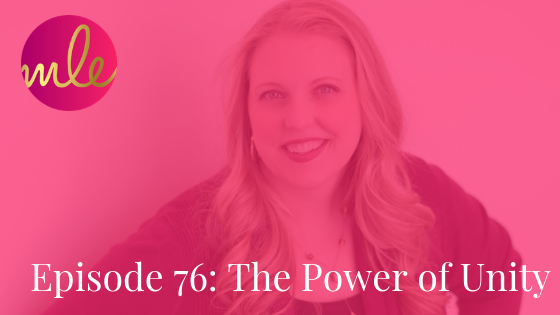
Episode 76: The Power of Unity
We’ re wrapping up our series on using Dr. Robert Cialdini’s principles of persuasion in your marketing funnel.
As we’ve been talking about in the last six episodes, Robert Cialdini introduced his original six persuasion principles in his book The Psychology of Persuasion.
Dr. Cialdini’s book first came out in 1984, which seems like ancient history at this point. The good news is that the original six principles still work today because basic human psychology hasn’t changed since 1984, but what HAS changed is how we interact with one another, right? In September 2016, Dr. Cialdini released a new book Pre-Suasion: A Revolutionary Way to influence and Persuade. In this book, he describes a new, seventh principle that he called unity.
To recap, the principles are:
- Social proof
- Reciprocity
- Commitment & Consistency
- Liking
- Authority
- Scarcity
- Unity
When you match up the principles of persuasion with your marketing funnel, you can create a profit engine that attracts clients, students, and customers for years to come so that you get profit without worry in your business.
So what is the principle of unity?
Have you ever been at a party or conference and met someone that went to the same university as you did or the same hometown? Or maybe you two previously worked at the same company. You felt an instant connection, didn’t you?
Well, that’s the principle of unity in action.
At some deeper level, we want to find people we connect with to feel like we’re united together.
It’s powerful. It creates community. It creates a sense of US vs. THEM. It creates a sense of belonging — which deepens the connection between YOU as a leader and your audience.
Let’s dive into this a little deeper.
 Biggest Show Takeaways:
Biggest Show Takeaways:
- Unity is really made up of two parts.
- The first part is the perception of being together.
- This is about a shared identity, like family, race, religion, nationality, and political preference. The most important piece here is that people feel connected to each other. When unity of identity is reached, there will be more acceptance, cooperation, sympathy, help, and trust — which results in more agreement.
- For example, Cialdini used his own college classroom to illustrate this phenomenon. He wanted to compare compliance attitudes of students and their parents by having both fill out questionnaires.
- Student compliance was always very high; college students don’t typically ignore homework assignments from a professor because they know that can lead to bad consequences — especially when it’s a simple survey to fill out.
- Parents typically responded at a far lower rate, often below 20%. I mean, why should they bother? They’re not getting a grade, right?
- Cialdini used the unity principle to make one small tweak to the assignment, and with this one small tweak, he increased the parent response rate five-fold from 20% to 97%. Cialdini said he would give the parent’s child ONE extra point on ONE test if their parents simply completed and returned the survey.
- Because of this TINY, insignificant advantage a parent could give their child, Cialdini got an almost perfect response rate.
- How can you put this powerful unity principle into action?
- One way is to use family language. By using family-related language, you can invoke the effect in a powerful way.
- For example, you might say, “Here’s what I’d advise my children to do…” or “If you were my mom… or if you were my sister, here’s what I’d tell you…”
- Using words like “sister, brother, kids, daughter, son, mom, grandparents, or whatever is appropriate depending on the age and situation of your audience can go a long way towards connecting and creating a sense of unity.
- The second part of unity is when a group works together, they are united and will literally form a unit. This can then lead towards mutual sympathy and support.
-
-
- For example, in 1941, the Japanese didn’t follow the lead of their Nazi allies in brutalizing Jews. This was due, at least in part, to a Jewish scholar making a single persuasive statement to Japanese leaders debating the issue: “We are Asian. Like you.” This shifted the mindset of the leaders, and they rejected the pressure to adopt Nazi tactics toward Jews.
- This simple act of showing they had a shared identity — even with a religious difference — saved countless lives. It’s creating an US vs. THEM identity, an IN Group vs. OUT Group.
- These shared identities can be genuine and authentic, or they can be a bit cringy (as they often are in politics).
- This principle can also be used in a really fun way to call to your audience.
- For example, Chubbies shorts and their hilarious antagonism towards cargo shorts, pants, and the office. Here’s an excerpt from their website manifesto that I'll link to in today’s show notes. It’s a GREAT example of using the unity principle — and it will make you laugh too:
- For example, Chubbies shorts and their hilarious antagonism towards cargo shorts, pants, and the office. Here’s an excerpt from their website manifesto that I'll link to in today’s show notes. It’s a GREAT example of using the unity principle — and it will make you laugh too:
-
-

- Another way to use unity is through “Co-creation.” People who are involved in the creation of something feel better about it. They see themselves almost merging with the creation and feeling as ”an insider part of it.”
- For example, a company was doing market research for a new fast-casual restaurant concept, Splash!
- Randomly chosen consumers were shown a description of the concept and asked for feedback. But, the exact language varied; a survey taker might be asked for “advice,” “opinions,” or “expectations.”
- The final question of the survey was how likely the consumer would be to visit a Splash! Those asked for “advice” were significantly more likely to answer positively. Asking for advice put the survey-takers in a “togetherness” frame of mind. They were helping to create the new concept — not just commenting on it.
Links mentioned in this episode:
- Washington Post experiment: Stop and Hear the music with Joshua Bell, an internationally acclaimed virtuoso widely regarded as one of the world’s greatest violinists (watch the video here)
- Dr. Robert B. Cialdini’s book Influence: The Psychology of Persuasion
- Dr. Robert B. Cialdini’s book Pre-Suasion: A Revolutionary Way To Influence And Persuade
- Chubbies Manifesto
- Episode 70: Persuasion Pillar #1
- Episode 71: Persuasion Pillar #2
- Episode 72: Persuasion Pillar #3
- Episode 73: Persuasion Pillar #4
- Episode 74: Persuasion Pillar #5
- Episode 75: Persuasion Pillar #6
- Marketing Funnel Quiz: https://www.michellelevans.com/marketing-funnel-quiz/



